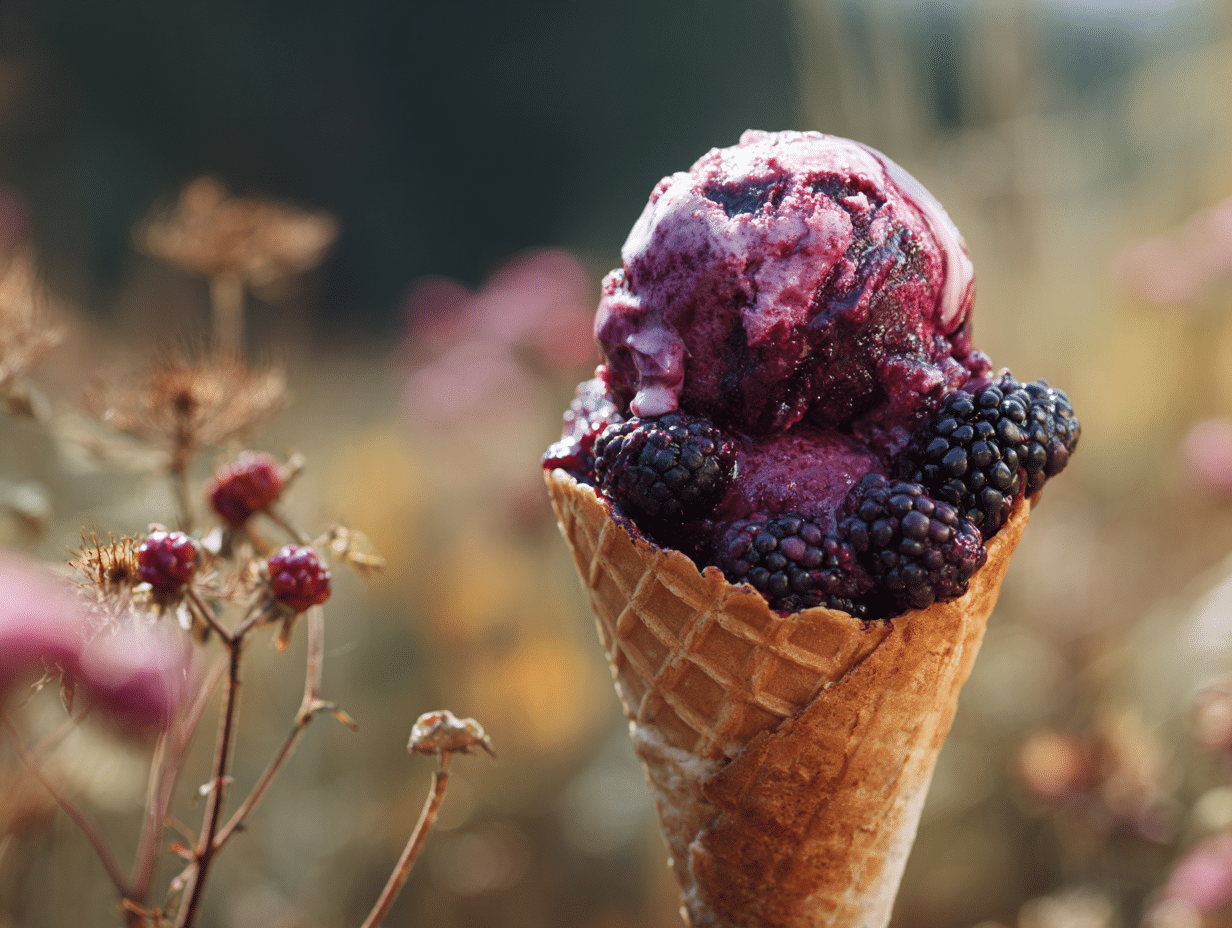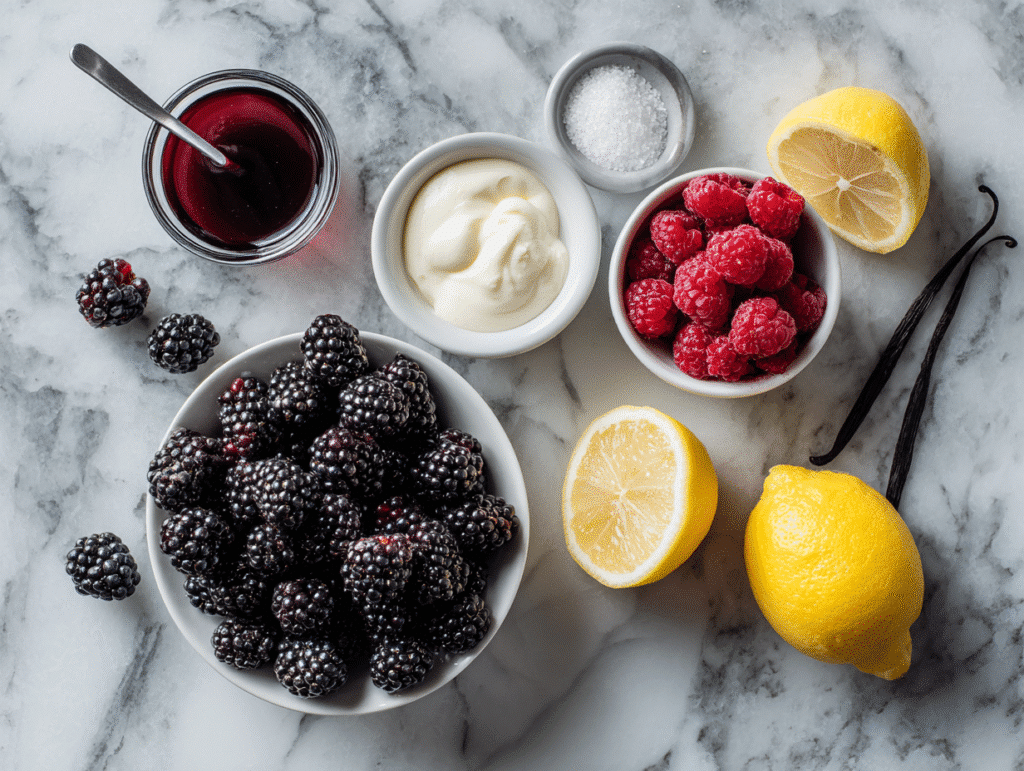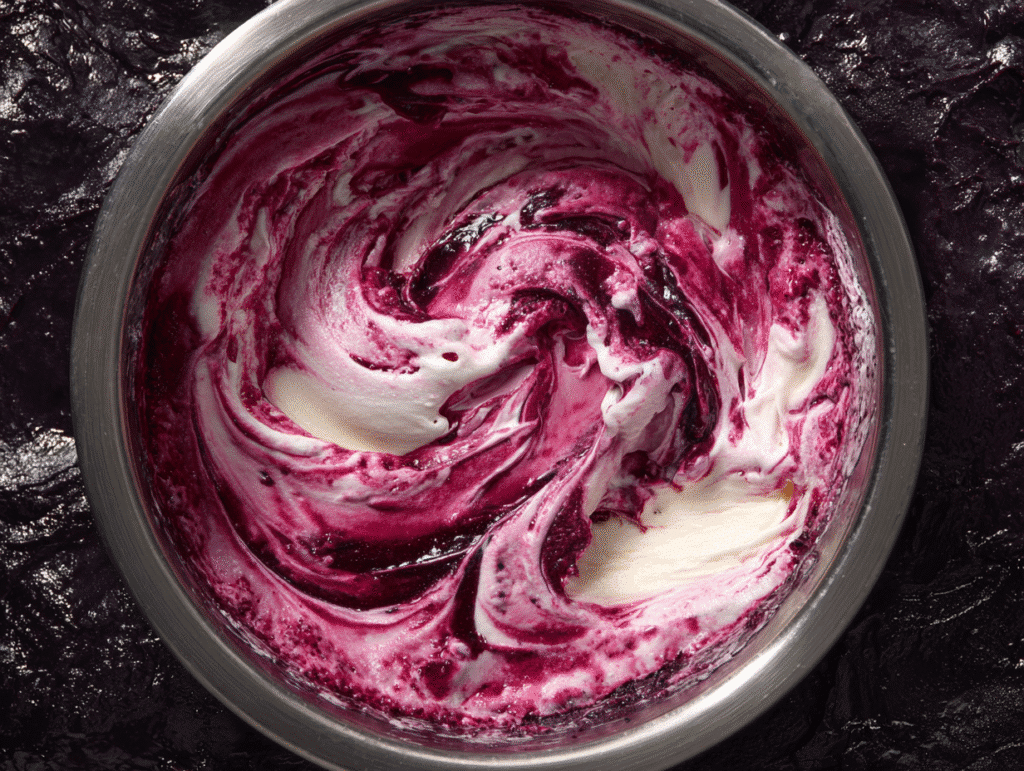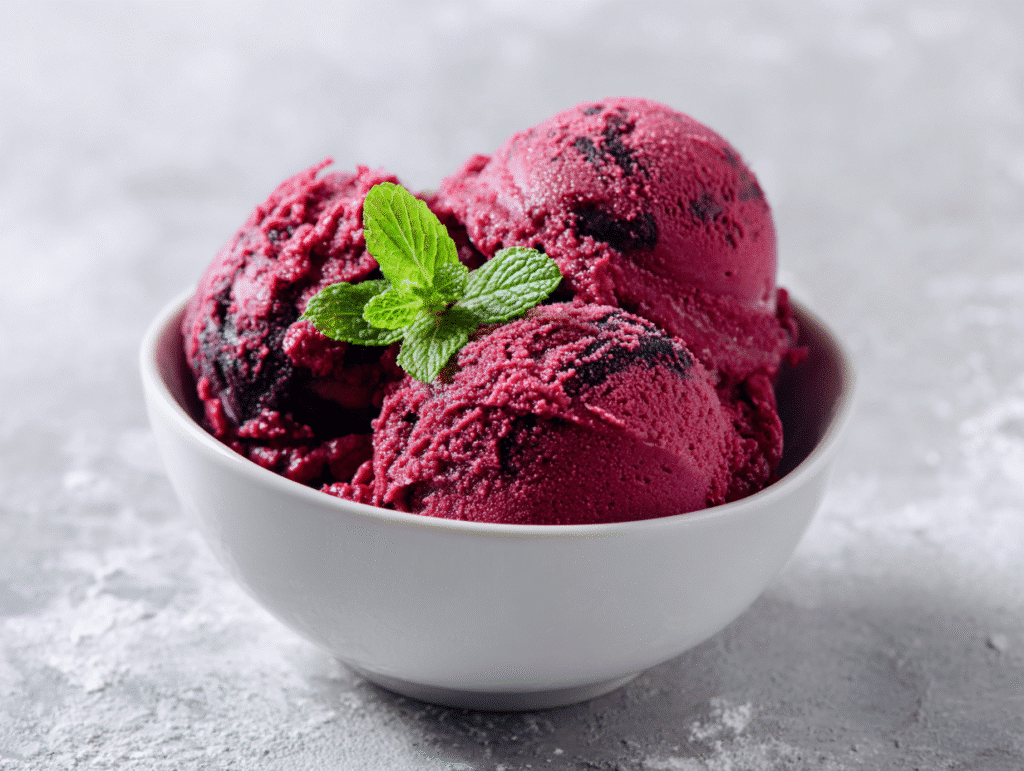Black raspberry ice cream isn’t just a dessert—it’s a bold, tangy-sweet memory you can taste. Whether you’ve stumbled upon it at a small-town creamery or whipped it up from scratch, this vibrant purple treat delivers flavor that’s both nostalgic and fresh.
In this article, we’ll explore how black raspberry ice cream is made, whether it’s healthy, what gives it that iconic color, and the truth about Red Dye 40. Plus, we’ll walk through ingredient tips, surprising flavor facts.
A Scoop of Summer — Why This Flavor Is So Loved
The Story Behind My Obsession With Black Raspberry Ice Cream
I remember my first bite of black raspberry ice cream. I was ten, and it came from a roadside stand on a scorching July afternoon. The color caught my eye first—deep purple, almost regal—and the taste? Tart, creamy, and so much more complex than vanilla or chocolate. That moment stuck with me. Every summer since, I chase that same thrill. Now, making my own version in my kitchen is part therapy, part tradition.
As someone who’s styled everything from layer cakes to artisan popsicles, this flavor has my heart. It’s a little old-fashioned and completely irresistible. Think No-Bake Summer Berry Lasagna meets Lemon Raspberry Layered Pie—layers of color and unexpected flavor.
Why Black Raspberry Ice Cream Stands Out
Let’s clear up one thing: black raspberries aren’t blackberries. They’re their own unique fruit—smaller, seedier, and more intensely flavored. Their bold purple hue and deep tang add a signature twist to traditional ice cream.
Unlike standard berry flavors, black raspberry has a naturally rich taste that plays perfectly with cream. It’s not as sweet as strawberry, not as mild as blueberry. That balance of tart and creamy gives it a gourmet edge.
You’ll also find black raspberry often paired with chocolate, vanilla swirls, or cheesecake bases, like in these Blackberry Cheesecake Brownies. No matter how it’s served, this flavor leaves a lasting impression—just the way a great summer treat should.
From Berry to Bowl — Making Black Raspberry Ice Cream
How Black Raspberry Ice Cream Is Made
Making black raspberry ice cream starts with one crucial ingredient: black raspberries. These rare berries are harvested during a short summer window and are prized for their intense flavor and deep purple color. The ice cream-making process usually begins by cooking down the berries with sugar to create a smooth puree or compote.
Next, the puree is folded into a custard base made from heavy cream, whole milk, sugar, and egg yolks. This mixture is gently cooked until thickened, then chilled and churned. The result is a silky, berry-forward ice cream with bold flavor and a striking hue.
Some versions skip the eggs and opt for a no-churn method using condensed milk and whipped cream—easier for beginners and just as dreamy. For a refreshing twist, some home bakers even swirl in a Blueberry Ganache or pair it with Blueberry Swirl Yogurt Bites for texture and contrast.
Natural vs. Artificial: What’s Really In Your Scoop?
Here’s the scoop: not all black raspberry ice cream contains real black raspberries. Many commercial brands use “natural flavors” or “black raspberry flavoring,” which may include a blend of berries and additives. One thing to look out for is Red Dye 40, a synthetic food coloring often used to enhance the purple color—especially if real black raspberries are limited or absent.
Red Dye 40 doesn’t alter the flavor, but it does raise questions about health and transparency. If you’re going the homemade route, you can avoid this completely by using fresh or frozen black raspberries. A splash of lemon juice can even help intensify the berry’s natural color.
For those looking to skip dyes and additives altogether, consider using fruit-forward, low-sugar recipes like this Cottage Cheese Ice Cream, which relies on natural ingredients for both color and flavor.
Is Black Raspberry Ice Cream Healthy?
Nutritional Facts You Should Know
Black raspberry ice cream walks the line between indulgence and potential health perks. On the indulgent side, it’s still ice cream—so yes, expect sugar, cream, and calories. A typical ½ cup serving delivers about 180–220 calories, with 10–14 grams of fat and 15–20 grams of sugar, depending on the recipe or brand.
But here’s the bright side: black raspberries themselves are nutrient powerhouses. They’re loaded with antioxidants, especially anthocyanins—the compounds responsible for their rich purple color. These antioxidants may support heart health, reduce inflammation, and even help fight oxidative stress.
So, while black raspberry ice cream isn’t a “health food,” using real berries does add a meaningful nutritional bonus—especially compared to flavor-only versions. And when you make it at home, you get full control over the sugar and fat levels, making it easier to enjoy mindfully.
Healthier Alternatives & Clean Ingredient Swaps
If you’re watching sugar or dairy, don’t worry—there are plenty of ways to enjoy the flavor without the guilt. Start by swapping in alternative bases like Greek yogurt, coconut milk, or even cottage cheese, like in this Cottage Cheese Ice Cream recipe. It’s high in protein, lower in sugar, and completely customizable.
Sweeteners like honey, maple syrup, or monk fruit can reduce the glycemic impact while still delivering flavor. You can also blend in fresh black raspberries with frozen bananas or avocado for a creamy, no-churn “nice cream” option that’s surprisingly decadent and dairy-free.
Looking for an ultra-refreshing summer spin? Try combining your berry base with the approach used in these Watermelon Popsicles—light, hydrating, and perfect for hot days. You’ll still get that bold berry bite, just in a leaner, lighter form.
Bottom line? Black raspberry ice cream can be as healthy (or as rich) as you want it to be. Choose ingredients with intention, and you’ll never have to feel guilty about that second scoop.
Flavor Trends & Brands Using Red Dye 40
Is Red Dye 40 Safe? What Science Says
Red Dye 40 is one of the most widely used synthetic food colorings in the U.S.—and yes, it does show up in some black raspberry ice cream brands. It’s approved by the FDA, but that hasn’t stopped controversy. While studies haven’t shown conclusive evidence that Red 40 is harmful in small doses, some research links it to behavioral sensitivity in children, especially those with ADHD.
The biggest concern? It’s often used to compensate for lack of real fruit, not for necessity. Red Dye 40 enhances color, not flavor, which means you’re getting the illusion of more berries than what’s actually in the tub.
If you want to skip it entirely, your best bet is to make your own ice cream or buy from natural brands that use ingredients like beet juice or berry extracts for coloring. These cleaner options mirror what you’d get in fruit-forward desserts like Strawberry Cheesecake Dump or Dark Chocolate Raspberry Pie Bars.
Which Ice Creams and Beverages Use It
Unfortunately, Red 40 isn’t limited to ice cream. It’s hiding in fruit drinks, flavored yogurts, cereals, and even medications. One of the most recognizable places? Strawberry Fanta—a neon pink soda that owes its color almost entirely to Red 40, not fruit content.
Some mass-market ice cream brands also use Red Dye 40 to give their black raspberry or “wild berry” varieties a consistent, vibrant hue. Check ingredient lists carefully; if “Red 40” or “FD&C Red No. 40” is near the top, the product likely contains very little real fruit.
Curious about whether milk has Red 40? Regular milk doesn’t—but flavored ones (like strawberry or berry milk) sometimes do, depending on the brand. The same goes for whipped toppings, sprinkles, and even some cherry sauces.
To avoid it altogether, shop with a “real fruit first” mindset, or stick to trusted recipes using whole ingredients. That way, the color in your ice cream comes from nature—not a lab.
Frequently Asked Questions
How is black raspberry ice cream made?
Black raspberry ice cream is made by blending a puree of fresh or frozen black raspberries with a creamy base of milk, cream, sugar, and sometimes egg yolks. The mixture is churned to create a smooth, berry-rich frozen dessert.
What flavor is black raspberry?
Black raspberry has a deep, tangy-sweet flavor that’s more intense than red raspberries or blackberries. It’s rich, earthy, and slightly floral—making it ideal for ice cream and fruit-forward desserts.
Is black raspberry healthy?
Black raspberries are loaded with antioxidants and fiber, making them one of the healthiest berries. When used in ice cream, they still offer some benefits, but the overall healthiness depends on the base ingredients and added sugars.
Does black raspberry ice cream have Red Dye 40?
Some store-bought black raspberry ice creams may contain Red Dye 40 to enhance color. Always check the ingredient label. Homemade versions with real berries typically do not.
Is Red Dye 40 safe?
Red Dye 40 is approved by the FDA and considered safe in small amounts. However, some studies link it to behavioral issues in children, and certain people may prefer to avoid it due to sensitivities or lifestyle choices.
Is red dye in ice cream?
Yes, red dye—especially Red 40—is often used in commercially flavored ice creams to enhance color. It’s common in fruit and berry varieties that don’t use enough real fruit.
Is Red 40 a natural dye?
No, Red 40 is a synthetic food coloring made from petroleum. It’s not derived from fruits or vegetables, unlike beet juice or annatto, which are natural alternatives.
Is there Red Dye 40 in strawberry Fanta?
Yes, Strawberry Fanta contains Red Dye 40 to achieve its bright pink color. It does not contain real strawberries.
Which brands use Red Dye 40?
Many mainstream food and drink brands use Red Dye 40 in their fruit-flavored products, including sodas, yogurts, cereals, and some ice cream lines. Always read ingredient labels for confirmation.
Conclusion
Black raspberry ice cream is more than just a summer treat—it’s a burst of bold flavor, a memory-maker, and, when made thoughtfully, a scoop of real fruit goodness. Whether you’re crafting it from scratch or checking labels at the store, knowing what goes into your ice cream matters. From antioxidant-rich berries to the buzz around Red Dye 40, this guide helps you enjoy every bite with more awareness—and maybe even a little extra appreciation for that deep, velvety purple swirl.
For more colorful, health-forward creations and behind-the-scenes peeks into my test kitchen, connect with me on Facebook and see what’s brewing daily on Pinterest. Your next favorite recipe might just be a scroll away.
PrintH1: Black Raspberry Ice Cream That Tastes Like Summer
- Total Time: 6 hours (includes chilling/freezing)
- Yield: 1.5 quarts 1x
- Diet: Vegetarian
Description
Creamy, berry-packed black raspberry ice cream made with real fruit and no artificial dyes. Perfect for summer days or homemade dessert nights.
Ingredients
2 cups fresh or frozen black raspberries
1 cup granulated sugar (divided)
1 tbsp lemon juice
2 cups heavy cream
1 cup whole milk
4 egg yolks
1 tsp vanilla extract
Instructions
1. In a saucepan, combine black raspberries, ½ cup sugar, and lemon juice. Simmer until berries break down. Strain and cool the puree.
2. In another saucepan, heat milk, cream, and remaining sugar until warm. In a bowl, whisk egg yolks. Temper yolks with warm cream, then return to pan and cook until thickened.
3. Strain custard and chill completely. Stir in vanilla and cooled berry puree.
4. Churn in an ice cream maker according to manufacturer’s directions.
5. Freeze until firm, at least 4 hours before serving.
Notes
Use frozen berries if fresh aren’t in season.
Skip egg yolks for a no-cook version using condensed milk and whipped cream.
Add chocolate chips or swirl in extra puree for variation.
- Prep Time: 20 minutes
- Cook Time: 15 minutes
- Category: Dessert
- Method: Churning
- Cuisine: American
Nutrition
- Serving Size: 1/2 cup
- Calories: 210
- Sugar: 18g
- Sodium: 35mg
- Fat: 15g
- Saturated Fat: 9g
- Unsaturated Fat: 5g
- Trans Fat: 0g
- Carbohydrates: 20g
- Fiber: 1g
- Protein: 4g
- Cholesterol: 120mg





